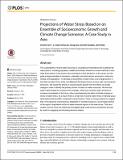| dc.contributor.author | Reilly, John | |
| dc.contributor.author | Fant, Charles W | |
| dc.contributor.author | Schlosser, Courtney Adam | |
| dc.contributor.author | Gao, Xiang | |
| dc.contributor.author | Strzepek, Kenneth | |
| dc.contributor.author | Reilly, John M | |
| dc.date.accessioned | 2017-05-05T22:35:17Z | |
| dc.date.available | 2017-05-05T22:35:17Z | |
| dc.date.issued | 2016-03 | |
| dc.date.submitted | 2015-01 | |
| dc.identifier.issn | 1932-6203 | |
| dc.identifier.uri | http://hdl.handle.net/1721.1/108715 | |
| dc.description.abstract | The sustainability of future water resources is of paramount importance and is affected by many factors, including population, wealth and climate. Inherent in current methods to estimate these factors in the future is the uncertainty of their prediction. In this study, we integrate a large ensemble of scenarios—internally consistent across economics, emissions, climate, and population—to develop a risk portfolio of water stress over a large portion of Asia that includes China, India, and Mainland Southeast Asia in a future with unconstrained emissions. We isolate the effects of socioeconomic growth from the effects of climate change in order to identify the primary drivers of stress on water resources. We find that water needs related to socioeconomic changes, which are currently small, are likely to increase considerably in the future, often overshadowing the effect of climate change on levels of water stress. As a result, there is a high risk of severe water stress in densely populated watersheds by 2050, compared to recent history. There is strong evidence to suggest that, in the absence of autonomous adaptation or societal response, a much larger portion of the region’s population will live in water-stressed regions in the near future. Tools and studies such as these can effectively investigate large-scale system sensitivities and can be useful in engaging and informing decision makers. | en_US |
| dc.language.iso | en_US | |
| dc.publisher | Public Library of Science | en_US |
| dc.relation.isversionof | http://dx.doi.org/10.1371/journal.pone.0150633 | en_US |
| dc.rights | Creative Commons Attribution | en_US |
| dc.rights.uri | http://creativecommons.org/licenses/by/4.0/ | en_US |
| dc.source | Public Library of Science | en_US |
| dc.title | Projections of Water Stress Based on an Ensemble of Socioeconomic Growth and Climate Change Scenarios: A Case Study in Asia | en_US |
| dc.type | Article | en_US |
| dc.identifier.citation | Fant, Charles, C. Adam Schlosser, Xiang Gao, Kenneth Strzepek, and John Reilly. “Projections of Water Stress Based on an Ensemble of Socioeconomic Growth and Climate Change Scenarios: A Case Study in Asia.” Edited by Kristie L Ebi. PLoS ONE 11, no. 3 (March 30, 2016): e0150633. | en_US |
| dc.contributor.department | Massachusetts Institute of Technology. Center for Global Change Science | en_US |
| dc.contributor.department | Massachusetts Institute of Technology. Joint Program on the Science & Policy of Global Change | en_US |
| dc.contributor.mitauthor | Fant, Charles W | |
| dc.contributor.mitauthor | Schlosser, Courtney Adam | |
| dc.contributor.mitauthor | Gao, Xiang | |
| dc.contributor.mitauthor | Strzepek, Kenneth | |
| dc.contributor.mitauthor | Reilly, John M | |
| dc.relation.journal | PLoS ONE | en_US |
| dc.eprint.version | Final published version | en_US |
| dc.type.uri | http://purl.org/eprint/type/JournalArticle | en_US |
| eprint.status | http://purl.org/eprint/status/PeerReviewed | en_US |
| dspace.orderedauthors | Fant, Charles; Schlosser, C. Adam; Gao, Xiang; Strzepek, Kenneth; Reilly, John | en_US |
| dspace.embargo.terms | N | en_US |
| dc.identifier.orcid | https://orcid.org/0000-0001-8820-470X | |
| dc.identifier.orcid | https://orcid.org/0000-0001-5595-0968 | |
| mit.license | OPEN_ACCESS_POLICY | en_US |
